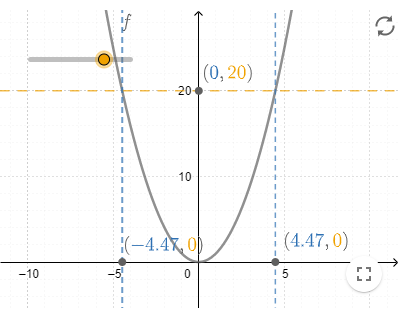Functions: Functions
 The range of a function
The range of a function
The values which a function #f:\blue X\to \orange Y# takes lie within the codomain #\orange{Y}#. However, not every element from the codomain #\orange{Y}# has to occur as a function value of #f#, as will be apparent in the following example.
|
The function #f: \blue{\mathbb{R}} \to \orange{\mathbb{R}}# with function rule #f(x)=x^2# has the minimum value #f(0)=0# and may further take all values greater than #0#. Thus, all of the values in the interval #\ivco{0}{\infty}# are reached by #f#. We therefore call #\ivco{0}{\infty}# the range of #f#. In the graph it can be seen that the horizontal line #y=\orange a# has points of intersection with the graph only if #\orange a# falls within the range of #f#. |
 |
We now give a formal definition of the range of a function #f#.
Range
For a function #f: \blue X \to \orange Y#, #\orange Y# is called the codomain.
The set of all function values #f(x)# in #\orange Y# for #x \in \blue X# is called the range of #f#.
If the range is equal to #\orange Y#, we call #f# surjective.
example
Of #f: \blue{\mathbb{R}} \to \orange{\mathbb{R}}#
with function rule #f(x)=-x^2#
the range is #\ivoc{-\infty}{0}#
A point #y# is within the range of #f# if and only if the equation #y = {{2}\over{x-10}}# has a solution in #x#
For #y \neq 0#,
\[\begin{array}{rcl}
y &=&\displaystyle {{2}\over{x-10}}\\
&&\phantom{xxx}\blue{\text{given function}}\\
y(x-10)&=& 2\\
&&\phantom{xxx}\blue{\text{multiplied both sides by }x-10}\\
x-10 &=& \dfrac{2}{y}\\
&&\phantom{xxx}\blue{\text{divided by }y \text{ (note that }y\ne 0\text{)}} \\
x &=&\displaystyle \frac{2}{y}+10\\
&&\phantom{xxx}\blue{\text{added } 10 \text{ on both sides}}
\end{array}\]
For #y=0#,
\[ \begin{array}{rcl}
0 &=&\displaystyle {{2}\over{x-10}}\\
&&\phantom{xxx}\blue{y=0\text{ entered in function}}\\
0(x-10)&=& 2\\
&&\phantom{xxx}\blue{\text{multiplied both sides by }x-10}\\
0&=& 2\\
&&\phantom{xxx}\blue{\text{calculated}}
\end{array}\]
We conclude:
- For each #y\ne0#, the equation #y = {{2}\over{x-10}}# has a solution #x#, namely #x={{2}\over{y}}+10#.
- For #y=0#, the equation becomes #0= {{2}\over{x-10}}#; it does not have a real solution.

Or visit omptest.org if jou are taking an OMPT exam.



